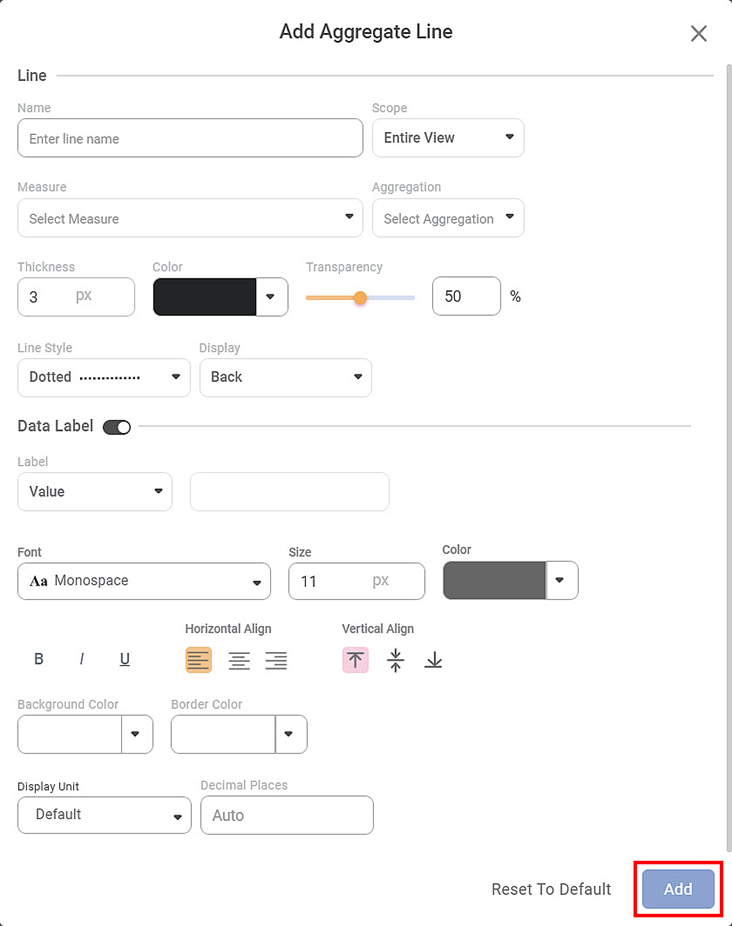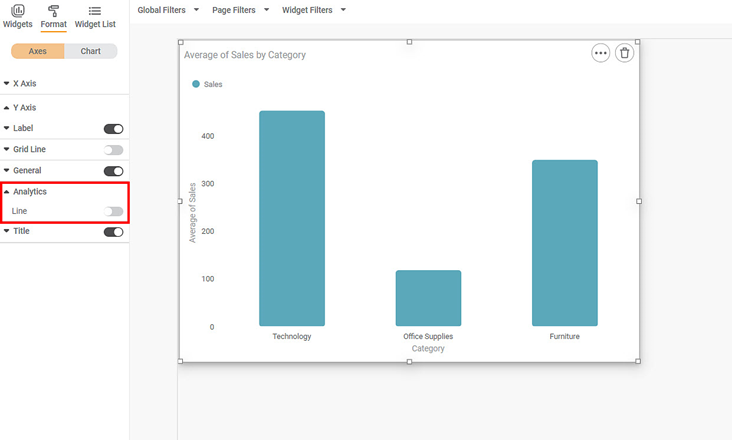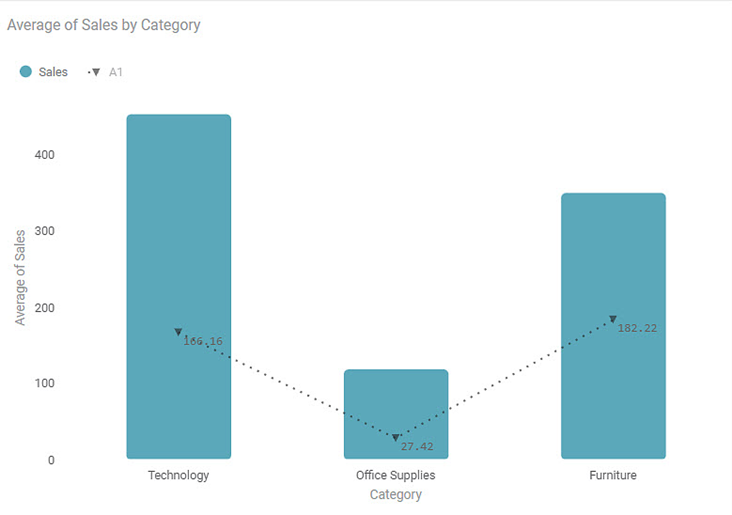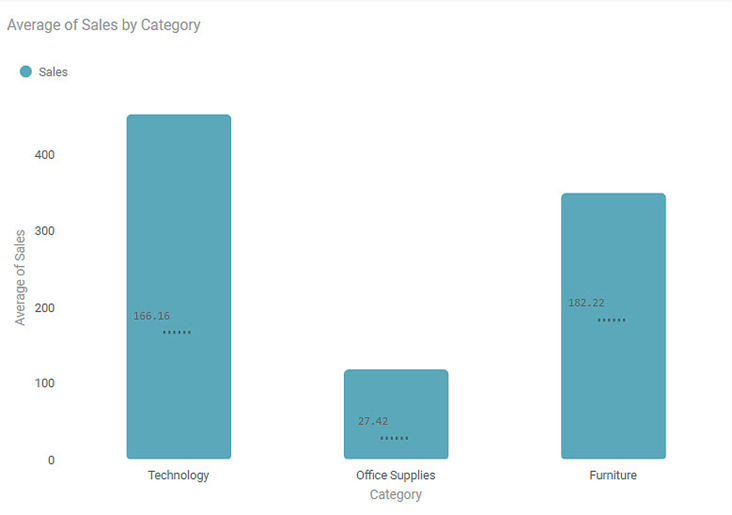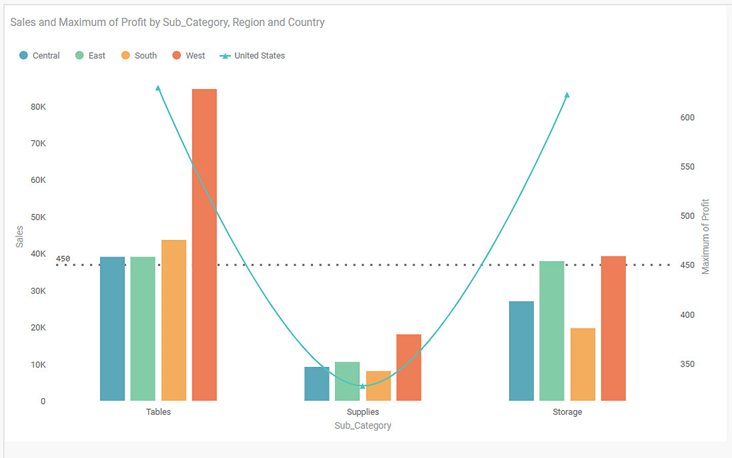The figure given below shows the Add Aggregate Line page.
The table given below describes different fields present on Add Aggregate Line page.
Section | Field | Description | Remark |
Line | Name | It allows you to select a name for the Aggregate Line. | · Select a proper name that is convenient to remember. · It is a mandatory field. |
Scope | It allows you to select the aggregation scope when X-split, Y-split, or both are applied to the widget. | · You can select any one of the following scopes o Entire View o Cell · When none of the splits is applied, o Entire View is the default scope option. · In Entire View, the line is considered for the entire Measure selected while plotting the widget. o For example, the Aggregate Line is drawn considering the average of the quantity. · In the Cell option, the data is aggregated for each cell of the widget. o For example, in the figure: Fixed Line for Line Y-axis in Combination Charts, a reference line is drawn using a Median of the Minimum of Sales for each Segment within the Category. | |
Measure | It allows you to select the variable/feature to be aggregated. | · You can select any one of the variables from the drop-down. | |
Aggregation | It allows you to select an aggregation method. This method generates a value corresponding to which the line is plotted. | · You can select any of the following methods o Mean o Median o Maximum o Minimum o Sum o Percentile It is a mandatory field. | |
Thickness | It allows you to select the line thickness. | The minimum and maximum values for thickness are 3 and 20, respectively. | |
Color | It allows you to select the line color. | By default, the color is black. | |
Transparency | It allows you to select the line shading concentration. | · The minimum and maximum values for concentration are 0% and 100%, respectively. · The 0% value indicates the lightest shade, and 100% indicates the darkest shade for the line color. · The default Transparency for the line shading is 50%. | |
Line Style | It allows you to select the line appearance. | · You can select any one of the following three types of appearances. o Dashed o Dotted o Solid · By default, the dotted line style is applied to the Aggregate Line. | |
Display | It allows you to select the line placement. | · You can select to place the line at the o Back or o Front of the plotted widget · By default, the reference line is placed at the Back of the widget. | |
Data Label | Label | It allows you to select the content displayed along with the line. | · You can select any one of the following labels. o Value o Custom Text · When you select the value, it automatically appears in the field next to Label. This field is not editable. · When you select Custom Text, you can insert relevant text in the field next to Label, to be displayed with the line. · You can make the Label bold, italic, and underline it. |
Font | It allows you to select the Label font. | You can select any one of the following font types: · Monospace (default) · Raleway · Roboto · Calibri · Times New Roman · Segoe UI | |
Size | It allows you to select the Label font size. | The minimum and maximum font sizes applicable are one (1) and 1638, respectively. | |
Color | It allows you to select the Label color. | By default, the color is light black. | |
Horizontal Align | It allows you to place the Label horizontally concerning the line. | · You can align the Label horizontally at the Left, Centre, and Right of the Fixed Line. · By default, the Label is always horizontally aligned to the Left. | |
Vertical Align | It allows you to place the Label vertically concerning the line. | · You can align the Label vertically Above the Line, On the Line, and Below the Line. · By default, the Label is always vertically aligned Above the line. | |
Background Color | It allows you to select the color for the background. | By default, the color is white. | |
Border Color | It allows you to border the region in which the Label is displayed. | By default, the color is white. | |
Display Units | It allows you to select the multiples of units in which the value is measured.
| · You can select any of the following units o Default o None o Thousand o Lakhs o Millions o Billions o Trillions · Default indicates that the unit is assigned automatically by parsing the value. · None represents that no unit is set for the value. | |
Decimal Places | It allows you to select the number of decimal places up to which you want to display the Label value. | The minimum and the maximum number of decimal places allowed are one (1) and nine (9), respectively. |
|
|
To insert an Aggregate line, first plot a Column Chart using the dimensions and measures from the dataset.
For example, we plot a Column Chart of the Average of Sales by Category.
By default, no reference line is displayed. The Line toggle is switched Off.
We configure the Fixed and Aggregate Lines by changing the Line and Data Label field parameters.
For the Aggregate Line,
- Select the Median as the Aggregation method
- Select the Scope as Entire View
The resultant widget is shown below.
If you select the Cell view as Scope (instead of Entire View) and Display as Front, then the resultant widget is shown below.
Now, on the same chart, if you apply an X-split using the Region dimension, and select Partition as the Scope view, then the resultant widget is obtained as shown below.
Similarly, in the case of Combination Charts, you can plot the Analytics Lines for both Column Y-axis and Line Y-axis.
The figure below shows a Combination Chart for Sales against Maximum Profit with Country as the Line Legend. A Fixed Analytics Line corresponding to the Line Y-axis (Maximum Profit) is plotted at a value of 450.
